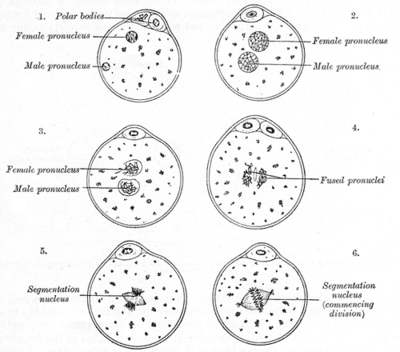Pronucleus

A pronucleus (plural: pronuclei) is the nucleus of a sperm or an egg cell during the process of fertilization, after the sperm enters the ovum, but before the genetic material of the sperm and egg fuse. Sperm and egg cells are haploid, meaning they carry half the number of chromosomes of somatic cells. The male and female pronuclei don't fuse, although their genetic material does. Instead, their membranes dissolve, leaving no barriers between the male and female chromosomes. Their chromosomes can then combine and become part of a single diploid nucleus in the resulting embryo, containing a full set of chromosomes.
The appearance of two pronuclei is the first sign of successful fertilization as observed during in vitro fertilisation, and is usually observed 18 hours after insemination or ICSI. The zygote is then termed a two-pronuclear zygote (2PN). Two-pronuclear zygotes transitioning through 1PN or 3PN states tend to develop into poorer-quality embryos than ones who remain 2PN throughout development,[1] and may be significant in embryo selection in IVF.
References
- ↑ Reichman DE, Jackson KV, Racowsky C (May 2009). "Incidence and development of zygotes exhibiting abnormal pronuclear disposition after identification of two pronuclei at the fertilization check". Fertil. Steril. 94 (3): 965–970. PMID 19476942. doi:10.1016/j.fertnstert.2009.04.018.
External links
| Look up pronucleus in Wiktionary, the free dictionary. |